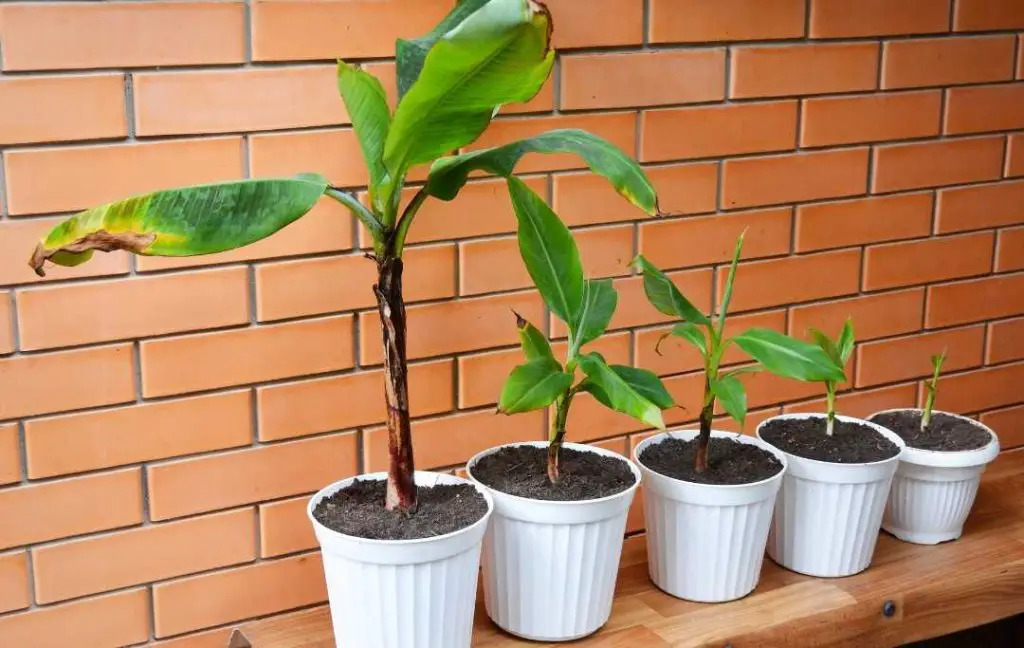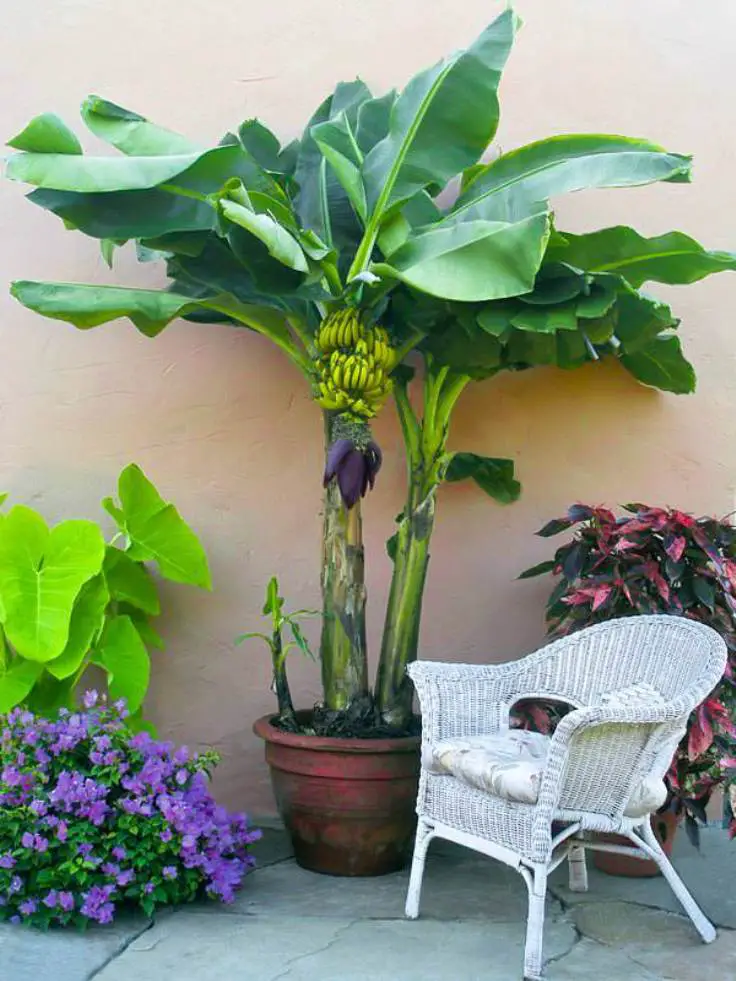Lack of space and cold climate are the basic reasons for growing banana plants in the pots. Growing a banana plant in the pot is not very difficult and the interesting thing is that you will get the same dramatic leaves you will get.
Banana is a herbaceous perennial and it is found in different varieties. These varieties range from ornamental to dwarf and flowering types.
Best Dwarf Banana Varieties For Growing In Pots
Banana is a tropical fruit that has great taste and it is full of nutrition. There are many varieties of bananas that are found in the world. Each variety has a unique color and flavor.
Here we are going to give you some options of banana trees, which are best for growing in the pots.
DWARF JAMAICAN
The other name of this variety is Cuben Red banana, when the fruit of this plant ripens then it will turn into sunset yellow. This type of banana is smaller than the Cavendish variety.
The color of the flesh is creamy to pink and the flavor of this variety is just like raspberry. You can eat the fruit raw and use them in making fruit salads.
DWARF CAVENDISH
This is a common variety that is found in green color when it is unripe. The color of ripe fruit is dark yellow with brown spots. This variety is best for making smoothies, banana bread, and smoothies.
LADY’S FINGER BANANAS
The size of this variety is very small but the flavor is sweet. If you want to make a portion control snack then you should grow this variety.
RED BANANAS
The skin of this variety is red-purple but the flesh is very sweet. The color of the flesh is pink and orange, when the fruit is fully ripe you will see the color of the flesh is cream to light pink. The taste of this variety is just like raspberry.
Growing Banana Plants In Pot

It is a lush green plant that grows very quickly if it grows in a tropical climate. You can choose any dwarf variety for growing in pots.
The interesting thing is that the banana plant needs little maintenance which makes it perfect for growing in pots and containers. The height of the tower can be between two 2 to 4 meters.
Read More
- GROWING STRAWBERRIES VERTICALLY IN TOWERS
- HOW TO GROW CHERRY TOMATOES IN A GREENHOUSE?
- GROWING CHERRY TOMATOES INDOORS
How To Grow Banana Plant From Corm?
After deciding the variety which you want to grow in the pot, The next step is preparing the soil for the pot or container.
Step 1: Choose A Deep Pot With Adequate Drainage
The right size of the pot is very important for growing banana plants. The diameter of the pot should be 20+ inches. It is recommended that the deep pot should be used because banana tree roots need room to expand.
Another important thing for the best pot is that it has drainage holes. Your pot can be made of ceramic, plastic, metal, or wood. It depends upon you which type of material you want for your pot.
When your plant grows and you will see the height of the plant is very large then you can transfer this plant to a larger pot. You should increase the size of the pot by 10 to 15cm every 2 to 3 years
Step 2: Get Well-drained And Mildly Acidic Soil For Tree
Well-drained soil is needed for banana plants. You can prepare healthy soil by mixing peat, perlite, and vermiculite. The other option for you is purchasing a high-quality potting mix from any nursery or gardening store.
Avoid using garden soil in the pot because some soil is not beneficial, for example, heavy potting soil which is found in your backyard. The pH of the soil must be between 5.6 to 6.5.
Step 3: Rinse The Banana Corm With Water
You can get banana corms from your local nursery. You can also purchase it online. This step is very important, you have to rinse the banana corm in lukewarm water before planting.
The reason is that if there are any pests on the corm then they will be removed from it. This will also help to remove any bacterial and fungal growth.
Step 4: Dig A Hole For Banana Form
At this stage, fill your pot with your prepared soil and dig a small hole in the center of the pot. The depth of the hole must be about 3 inches. The depth of the hole can be increased according to the size of the corm.
Leave enough space around the corm because it will help to plant it deep into the pot. When you place the corm then 20% of it sticks out of the hole. New leaves will sprout at this part of the plant which is exposed. When the corm is planted then fill the gaps on the side with soil.
Step 5: Water Your Plant
After planting, your plant needs regular water. The drainage holes at the bottom of the pot will help to drain out the water. You should use a watering can to water your banana plants regularly.
But avoid overwatering because it will result in root rot. It is suggested that never put your pot in a saucer because it can lead to bacteria and rot.
How To Grow Banana Plant From Seeds?
- For growing banana plants from seeds, you should soak the seeds first in warm water for 24 to 48 hours. This will break the seed dormancy and speed up the germination process. The seed coat of the seeds will become soft and the embryo will sprout very quickly without any effort.
- Take a small pot and fill it with high-quality potting mix.
- Now sow the seeds ¼ inch deep in the soil. Cover the seed with compost for the healthy growth of the plant. After sowing the seeds water them so the soil becomes moist.
- For the germination of seeds, the suitable temperature should be at least 16 degrees Fahrenheit or 15 degrees Centigrade
- When the seed germinates then carefully repot the plant in a large container. Make sure the roots of the plant should not damage or disturb. Fill the container with well-drained soil with good quality compost.
- The duration of germination of seed depends upon the variety which you choose. Generally, banana seeds take 2-3 weeks to 2-3 months for germination.
How To Care For Your Banana Plant?
LIGHT AND WATER
Full sun exposure is very important for the healthier growth of your banana plants. Choose the right spot for your plant where it gets maximum sunlight. Every day your plant needs 6 to 8 hours of direct sunlight.
As the banana plant has large leaves so It needs lots of water to keep well hydrated. You should check the soil of the container for the pot frequently. In the summer season, when the weather is very hot and the sun’s strong heat makes your plants dry, the plants need more water to drink.
In the case of indoor plants, the humidity level might be below so you should keep the soil moist. But avoid overwatering because it will rot the roots. Root rot is caused by standing water in the pot’s saucer.
SOIL AND FOOD
Well-drained and rich soil is needed for your banana plant. A layer of mulch will help to retain the moisture in the soil. It will also add nutrients to the soil.
All-purpose fertilizer is the best option for feeding your banana plant. You will get all the instructions on the package. These instructions and tips are very helpful during the use of fertilizer.
PROTECTION
If you choose a good sunny location for your plant and provide rich soil but your plant is not protected from wind and cold temperature. Then the harsh weather can damage your plants.
On cold days, set the pot in a warm area. Frost is not good for your plants, It will kill your plants so for protection you should cover the plants with a blanket or burlap.
If you are living in a cold climate then you should spread a layer of mulch on the soil or bring your banana plant inside the home. The temperature of the soil should be above 22 degrees Fahrenheit for the survival of Banana plants.
FERTILIZER
Fertilize your banana plant once a month. The best fertilizer for the banana plant is which contains nitrogen, potassium, and magnesium. You can use soluble fertilizer which can dissolve in water.
The other option is granular fertilizer which you can sprinkle on the top of the soil. Make it possible that your plants get regular fertilizer because the roots of the plant will get proper nutrients and minerals. As a result, your plants will get developed properly.
- The best time for fertilizing your banana plant is Spring and Summer. You can fertilize your plant every week.
- If you are not using soluble fertilizers then you can also use a balanced 20-20-20 fertilizer.
PRUNE YOUR TREE
For the healthy growth of your banana plant, you can prune the plant after 6 to 8 weeks. As you are growing a banana plant in a pot or container so regular pruning is needed.
When the stem grows, it develops the center of the stalk which produces fruit each. Stalk supplies flower clusters. As the banana plant grows the suckers will start to form on the plant.
You should eliminate the suckers one by one from the plant. The healthiest and largest sucker should be chosen. As the plant grows taller, you should trim it again.
When you harvest the fruit then prune the tree but the main sucker should not be disturbed. if you removed all the suckers then the mother plant will die.
HUMIDITY
The banana plant likes to grow at humidity levels above 50%. If you want to increase the humidity level around the plant, mist the plant and you can place a layer of pebbles in a tray filled with water for this purpose.
POTTING AND REPOTTING OF BANANA PLANTS
You can grow a banana tree in a pot effortlessly but your pot must be 15 gallons for optimal growth of the banana plant. A pot with drainage holes and a rich potting mix will produce good-quality fruit.
As you are growing your banana plant in the pots then you can bring these plants inside your home especially in the cold weather. Banana trees need high watering and feeding, if you provide better conditions to your plants then they will grow faster.
Most people grow banana plants for their foliage. you should divide and repot container banana trees every three years and remove the suckers from the plant.
PESTS AND DISEASES
Bananas are quite resistant to disease but sometimes your banana plant will show the symptoms such as the leaves turning brown and drying at the edges.
The reason for this change is due to overwatering that’s why the leaves are turning yellow. The other reason for this is that your plant has a lack of nutrients.
Some pests may also attack your banana plant. These pests such as banana weevil, aphids, and coconut scales are harmful to your banana plant. You can use organic pesticides to get rid of this problem.
WINTER CARE
If your banana plant is too large that you can’t fit it inside then you should cut back. After the first frost, choose a cool and dark spot for your pot. At this stage, your plant needs enough water.
When the frost is predicted then remove the banana and its root ball from the pot and place the roots in the plastic bag. Leave the foliage outside the bag and keep this bag in the basement or garage now your plant needs no water.
Read More


